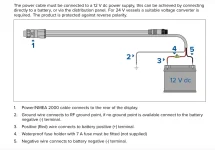Streff
Active member
- Joined
- Oct 15, 2019
- Messages
- 64
- Status
- OTHER
- Hatteras Model
- 53' EXTENDED DECKHOUSE (1983 - 1988)
I am installing a new Autopilot control system. I need to ground it to avoid electrolysis, etc. I identified a bonding lash on the Starboard side under the FB helm next to the decommissioned SSB box. To my surprise, the other end of the bonding belt goes down a chase tube toward the space behind the Pilothouse seat and it’s dangling free in space, not connected to anything at all. And there is nothing around where it logically can be connected to another ground lead.
There are a bunch of electronics equipment under the helm dash, I assumed that I can find where do they all ground. After a day of looking everywhere, I cannot locate a green ground connection on the FB, other than the lash to nowhere.
Any comments or ideas as to where I may find a ground on the FB would be much appreciated.
Streff
There are a bunch of electronics equipment under the helm dash, I assumed that I can find where do they all ground. After a day of looking everywhere, I cannot locate a green ground connection on the FB, other than the lash to nowhere.
Any comments or ideas as to where I may find a ground on the FB would be much appreciated.
Streff


